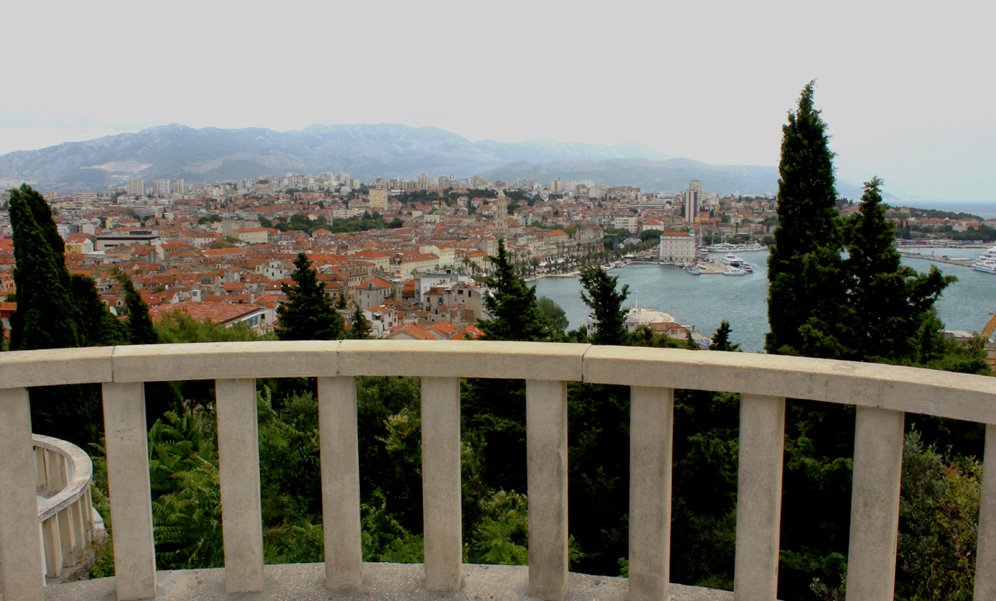In the middle of the Football world cup in 2014, we decided to see another part of Europe. Until the moment, being completely honest, I had ignored it almost entirely. The world cup was especial for us: Colombia and Germany had moved to the next round and our host, Croatia, had given it its all in the field. It was exhilarating. This is how we discovered one of many paradises. This is how we discovered Split, a city born form a palace.
Dalmatia
The Dalmatia region, especially Split, is a center point for all the dalmatian coast, a city of 200,000 inhabitants. Split is only 400 km away from the capital, Zagreb.
It’s economies backbone is tourism, naval industry and a few other industries that make this city an important business place. Split is a part of Central Dalmatia and it is surrounded by the Kosjak and Mosor mountains.

It is Mediterranean. It is an important place because it is connected with all of the country, there are many ferries that connect Split with most of the islands, as a result there are a lot of tourist.
As soon as we arrived, a cloud of tourist welcomed us, however, our first breath was of freshness and novelty. It’s streets, as I saw first hand, are overthrown by hundreds of travelers that go the the Dalmatian coast in order to be caressed by the Adriatic.
The scenery is beautiful, the history of their people and cities are grand, their architecture and art are abundant, gastronomy is excellent and their hospitality is unquestionable. The imposing stone wall contrast with the intense ocean blue, the perfect way of starting an adventure in paradise. Obviously, we are not the first to think that Split is paradise, and we will not be the last.
The history
As all cities, this one has its history. This city grew surrounding the getaway house of the roman emperor Diocletian, who was born in 245 a. C. In the year 305 he went to this palace and after a few years death found him there, he was buried here in 313.
Around the home small gathering of roman soldiers were created and between the palace and its surroundings, the population reached between 8.000 and 10.000 people. As time went by the city was being created.

As years came and went, the palace became a roman uniform industry and the center point of the city. At the beginning of the VII century, the roman city of Salons was plundered by the Euresian Avars (Central Asian nomads). All the refugees turned the palace into a fortified city and Diocletian’s mausoleum in the cities cathedral. The palaces structure has a squared base, which is typical of roman times.
The wall bounded city has narrow streets, arcs and inner bridges. Shadows are the main character. Moreover, the small paths and tunnels where the sun doesn’t shine make the tour around the city much better under the intense heat.
The most common access is the Aurea Door. How ever, there are four monumental doors: Auera Door, Porta Argenta, Porta Ferrea and Porta Aenea. With each step it is possible to admire the Italian marble and red granite. Having his in mind, in 1979, the UNESCO declared it a World Heritage Site.
The main avenue of the wall in city is crowded as the day goes by. Hundreds of tourist and locals. People offering one euro tours of the ancient walled city, of this historic jewel. A spectacle of the emperor and its court. During the sunny hours of the day, the marble that covers the street in the main avenue shines and the light reflects the light.
From the heights
Afterwards, it was the moment to experience the city from clouds. In order to do this, we climbed the bell tower near the mausoleum of the palace. The stairs are narrow, cream colored stone, and with every step you go closer to the heights, the wind is stronger.
The stairs are uncomfortable and the amount of people walking make the situation even more complicated. Before going up, workers and other tourists, tell you the climb is not meant for people with a faint heart. And truth be told they are not laying. The bell tower is the center point of the palace. Without a shred of a doubt, the view form the highest point of the bell tower is impressive.
Colors change as you shift from window to window. The red tiles become the main character of the scenery as it contrasts with the deep blue ocean and the green vegetation. In the far, the islands take charge of the deep blue form the heights. Each one of this images could be a postcard.
After spending a few hours in the beach the walk back lets us enjoy the streets, and discovering the amber toned walls during the sunset is possible.

But, our ancestors history goes way beyond a roman palace. There are other important archaeological sites, such as: Jupiter’s Temple and Diocletian’s Mausoleum that with time became St. Duje’s Cathedral. In St. Duje’s Cathedral is a must. It is an ornamented altar and roam Gothic bell tower. Another majestic piece of art was made by Buvina, the architect, Jesus life is represented in the Cathedrals door.
The Maritime Walk, not only is it a must but also beautiful. In it you can find the Rublike square, very near the roman church of Saint Lorenzo and Popolo Square.
Undoubtedly, this city is the perfect place to loose yourself because the streets are never ending streets inside a maze. A maze that has different architectonic styles meshed and that wraps us in salt residue.
Only 15 minutes away from the old city of Varos the Park. It is a green oasis that is very well cared, perfect for long walks, visiting the zoo or focusing on the amazing scenery of the city and the crashing waves. The outer most point of the peninsula is covered by 340 hectares over 3,5 km in longitude and 1.5 km width. Its peak is Marjam and it is 178 meters high. It has always been considered to be Split’s lungs, only a few meters away from the city center.
Culture, art and maritime life
Split is culture, art, maritime life and relaxation. Another aspect that people should consider is that Split is a very easy access city. Moreover, the historic part of the city is only for pedestrians, so in order to get a cab or bus people have to leave the city center.

The train station, bus and ferry are a short distance away. I realized that one of the best options, is sleeping at an Apartmani.
I know it was weird are rooms that are between a bed and breakfast and serf service and that sometimes are in historical buildings.
As I noticed, Split it extremely popular in the summer, time in which most of the activities and festivals take place. Every Saturday there are classical music concerts.
Split is famous for the maritime walk, night spots in front of the sea and spirited bars in the old city.
The place to be is there. In the wall in city, music is turned off at 1:00 am. And from that moment on, the night scene goes to Bacvice Beach.
Everything isn’t perfect
Not everything is perfect and every place has a past. As many chapters in our history, it is difficult to imagine that this city and this country where in a war.
It is challenging to imagine the suffering of the people when the war has already gone by. Refugees had to take shelter from crossed fire that surrounded them.
The beginning of the Bosnia-Herzegovina war in April 1992 was something that did not touche me, I am sure that more than indifference it was the fact that it never crossed my mind.

After World War II, Croatia became a unidad federeal socialista unipartidista from Yugoslavia. In the eighties the political situation in Yugoslavia went down hill. In January 1990 the Yugoslavian communist party cracked and the first elections with several political parties took place.
This was never meant to be a peaceful transition period. There where many ethical and political problems which concluded in the Croatian War of Independence, moment in time in which the Yugoslavian Popular Army and several Serbian paramilitary groups attacked.
By the end of 1991, an intense war diminished the Croatian controlled to a third of its territory. War finally came to an end in 1995 and Croatia won. July 1st 2013 Croatia became the 28th member of the European Union, and left the possibility of a new Balcan war far behind.
More lavender and pine for next time
Last but not least, this city is the entrance of the most popular island Croatia offers, mainly regarding the night activities. Hvar, the little Croatian Ibiza, welcomed 30.000 visitor each summer. Its harbour is the perfect place to find all types of fun activities and experiences.

From Split you can reach the island in one hour with the Jadrolinija company or with Krilo. This island has witnessed much of the development of our history and society.
The first human settlements date from the time of the Illyrians. The Illyrians were an ancient Indo-European people from the Balkans. But, it only acquired relevance until the Greeks arrived.
The island smells of lavender, rosemary and pine, riddled with virgin forests and white sand beaches. The charm of Hvar lies in the mixture of architectural styles, Gothic, Renaissance and in the prominence that the Venetian aristocracy has given this place. The warm water and exquisite climate of the Mediterranean sunset called us, calmed us, asked us to dive into the sea of Hvar and have one more drink. Croatia, the country of a thousand islands.


